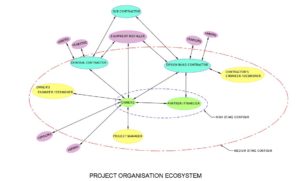Temporary association between organizations to execute projects in defined time and cost
Contractual Relations
Projects are set of operations with a finite duration. Organizations execute projects or parts thereof through a temporary association called Contract with other organizations. The organization that seeks an association is legally called first-party or proponent. The first party is usually a predominant stakeholder of the project whereas other party or parties agree to perform prescribed responsibilities in exchange for a monetary benefit or stake or combination thereof. In monetary transaction contracts, first-party is contextually called client and other parties are called contractor/agency. In stake sharing contracts, parties are contextually called partners and the contract is termed as a joint venture. Sometimes sub-contracts are made between a partner or contractor of an existing main contract to execute a part of the work assigned on the main contract.
“Contracting parties have different, sometimes conflicting objectives. Hence, all expectations of clients and contractors should be recorded on a contract agreement, to avoid future conflicts.”
Characteristic features of contracts can be enumerated as follows:
- Contracting parties have different, sometimes conflicting objectives. Hence, contracts should be bound over a set of minimum common objectives, that include project duration, technique/methodology of delivery, quality/performance expectations and/or safe practices. In the best of practices, contract documents are prepared by the first party to subsequently invite interested parties to associate. The contract documents should also define a set of metrics that are measurable and form the basis of comparison among prospective bidders and also compensation to successful bidder during/after execution. Sometimes, in informal design-build contracts, proponents may leave the entire proposal to the bidder, resulting in different items and stages proposed by different bidders. It is advised to use two or more different tenders to evaluate the bids in this situation, after receipt of physical bids.
- A distinctive life-cycle can be identified on contracts, due to their temporary nature. The offers or bids from prospective parties are evaluated with a prescribed criteria to award the contract to selected bidder; this process called bidding or tendering. Award is followed by contract execution, successful or otherwise; thereafter the contract is closed out.
- Contracts should be legally enforceable in the event of a breach, non-compliance or performance failures by either party. It is formidable to anticipate all likely complications that may entail over the project duration. It is also not easy to resolve emerging disputes, whatever be the merit in the legal framework of the contract. Hence, it is customary to make preemptive provisions in favour of first-party, especially justified in case of construction of immovable assets in premises of the first party. Breaches by first party can be resolved with relative ease due to the geographical localisation of first-party, whereas other parties seldom belong to the project by location. It should be noted that excessive precautionary measures tend to restrict the entry of prospective bidders and reduce the competitiveness of the bidding process. Preemptive precautions also may not work for sub-contracts as both parties do not geographically belong to project location.
“While inviting bids, clients must ensure that they are not comparing apples against oranges. There is a strong inclination of clients towards the lowest priced bidder, who may not but have completely understood the scope. Hence, evaluation criteria should be standardized, among all bidders.”

The collection of all contracts in a project, comprising of service providers, design engineers, supervisors, material/equipment vendors, finance providers and other stakeholders is called the Project Organization. Methods of project organization depend on the extent of works assigned to the contractor.
“The content presented above is the sole property of Adept Algorithms and shall not be reproduced in part or whole without prior permission”



